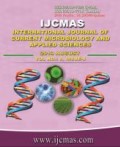


 National Academy of Agricultural Sciences (NAAS)
National Academy of Agricultural Sciences (NAAS)

|
PRINT ISSN : 2319-7692
Online ISSN : 2319-7706 Issues : 12 per year Publisher : Excellent Publishers Email : editorijcmas@gmail.com / submit@ijcmas.com Editor-in-chief: Dr.M.Prakash Index Copernicus ICV 2018: 95.39 NAAS RATING 2020: 5.38 |
Rural development as an integrated concept of growth and poverty elimination has been of paramount concern in all the consequent Government Schemes. The major challenge for our Governments is to offer solution that enables rain fed farming towards sustainable agriculture. “Krishi Bhagya” is the Government‘s flagship programme is a step towards to achive sustainability among rainfed farmers of the state. Government is supporting farmers to make a farm pond with polythene lining (to prevent percolation), install pump and sprinkler irrigation system (for efficient water utilization). This intervention helps farmers to harvest surplus rainwater and use it as lifesaving irrigation to sustain the production and thereby it is possible to enhance the yield by 30 per cent. In order to evaluate the performance of the scheme the study has made use the primary data. Primary data was collected from 15 beneficiaries and 10 Non-beneficiaries by using pre-tested structured schedules. The required data was collected from different sources, beneficiary households and villages. The data clearly indicates that the cropping pattern has been changed along with net income and no of irrigations per acre in both the districts. In Davanagere District after the implementation of KrishiBhagya Paddy and maize crops were replaced by Tomato and chilli. Where as in Chithradurga maize and groundnut were replaced by onion and marigold.
 |
 |
 |
 |
 |